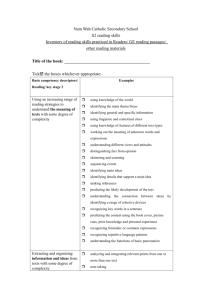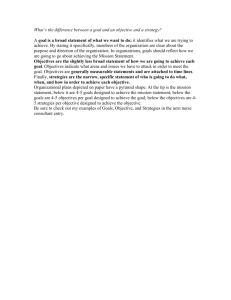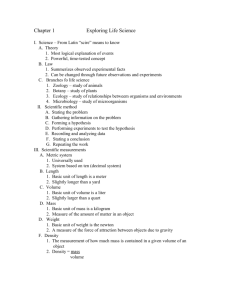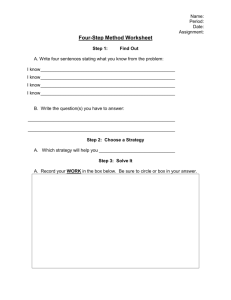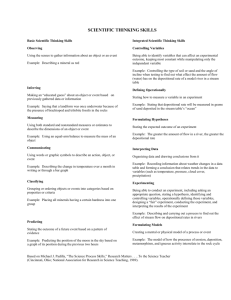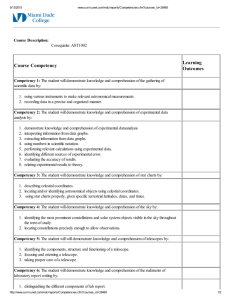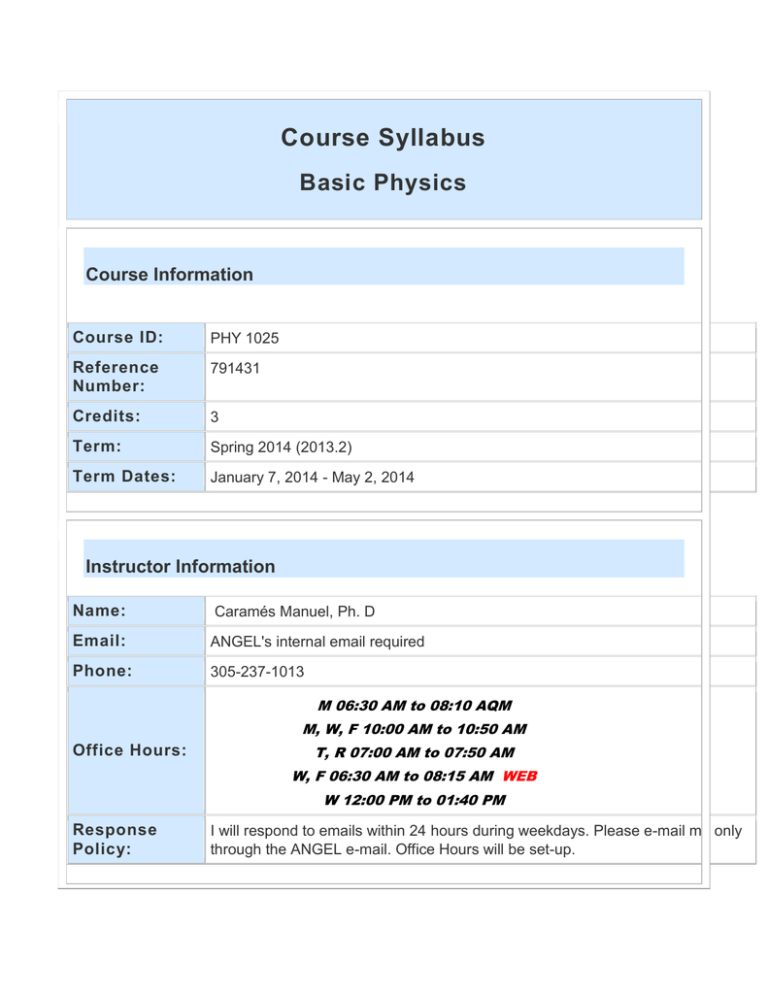
Course Syllabus
Basic Physics
Course Information
Course ID:
PHY 1025
Reference
Number:
791431
Credits:
3
Term:
Spring 2014 (2013.2)
Term Dates:
January 7, 2014 - May 2, 2014
Instructor Information
Name:
Caramés Manuel, Ph. D
Email:
ANGEL's internal email required
Phone:
305-237-1013
M 06:30 AM to 08:10 AQM
M, W, F 10:00 AM to 10:50 AM
Office Hours:
T, R 07:00 AM to 07:50 AM
W, F 06:30 AM to 08:15 AM WEB
W 12:00 PM to 01:40 PM
Response
Policy:
I will respond to emails within 24 hours during weekdays. Please e-mail me only
through the ANGEL e-mail. Office Hours will be set-up.
Course Description
This course will facilitate the transition from high school to college/university physics.
Content includes units of measure, conversion of units, right-angle trigonometry,
graphing, vectors and vector addition, one- and two-dimensional motion, circular motion,
Newton’s laws of motion, work and energy, and force fields. The course will emphasize
problem-solving techniques.
This course may be used to satisfy one of the Natural Science requirements.
Students, who do not have a prior course in physics and whose program of study
requires the completion of physics with calculus, must successfully complete PHY 1025.
PHY 1025 will also provide a foundation for the successful completion of PHY 2053 for
students with no prior physics background.
Prerequisites
MAC1105
Miami Dade College's Learning Outcomes
This course addresses the following MDC learning outcomes:
Learning
Outcome #1:
Communicate effectively using reading, and writing skills.
Learning
Outcome #2:
Use quantitative analytical skills to evaluate and process numerical
data.
Learning
Outcome #3:
Solve problems using critical and creative thinking and scientific
reasoning.
Learning
Outcome #4:
Use computer and emerging technologies effectively.
Learning
Outcome #5:
Describe how natural systems function and recognize the impact of
humans on the environment.
Learning
Outcome #6:
Create strategies that can be used to fulfill personal, civic and social
responsibilities.
Course Competencies
Upon completion of this course, the student will be able to:
Competency
1:
The student will demonstrate knowledge, comprehension, application
and synthesis of units and dimensions by
a) Stating and recognizing the fundamental dimensions of mass,
length, and time.
b) Expressing the dimensions of physical quantities in terms of these
fundamental dimensions.
c) Evaluating the consistency of formulas through consideration of the
dimensions involved.
d) Stating approximate measurements of ordinary objects using either
SI or British units.
e) Converting between different units of measure.
f) Stating and recognizing the decimal pattern and prefixes used in
the metric system.
g) Deriving the conversion factors for area and volume units from the
related length conversion factors.
h) Stating and recognizing the units of all the physical quantities
discussed in this course.
i) Expressing the units of complex physical quantities discussed in
this course in terms of simpler units.
Competency
2:
The student will demonstrate comprehension and application of
scientific notation by
a) Converting powers of ten to their ordinary decimal representation.
b) Converting between scientific and standard notation.
c) Performing calculations with scientific notation.
d) Utilizing a scientific calculator in doing calculations.
Competency
The student will demonstrate comprehension and application of
3:
significant figures by
a) Counting the number of significant figures in a given measurement.
b) Keeping track of the proper number of significant figures when
expressing values of physical quantities.
performing mathematical operations.
Competency
4:
The student will demonstrate knowledge, comprehension, and
application of applied geometry by
a) Measuring lengths using rulers marked in centimeters and in
inches.
b) Measuring and drawing angles using a protractor.
c) Stating and applying formulas for areas and volumes of bodies.
d) Calculating the perimeter of a polygon.
e) Calculating areas and volumes of symmetric bodies.
f) Stating and applying the formulas for the area and circumference of
circles.
Competency
5:
The student will demonstrate knowledge, comprehension, and
application of applied trigonometry by
a) Solving problems involving the lengths of sides and measures of
angles in right triangles by using the Pythagorean theorem and the
definition of sine, cosine, and tangent.
Competency
6:
The student will demonstrate knowledge, comprehension, application,
and analysis of the relationship between two directly proportional
variables by
a) Recognizing the conditions under which two variables are directly
proportional.
b) Recognizing analytically or graphically when two quantities are in
direct proportion.
c) Obtaining graphically or analytically the constant of proportionality
between those quantities.
d) Calculating unknown values of directly proportional quantities
using known values of those quantities.
Competency
7:
The student will demonstrate knowledge, comprehension, application
and evaluation of vectors by
a) Stating the definition of vector quantities.
b) Distinguishing between vectors and scalars.
c) Distinguishing between the magnitude and direction of a vector.
d) Representing vectors graphically accurately and to scale.
e) Obtaining the components of vectors graphically and by
trigonometry.
f) Converting vectors from polar to rectangular coordinates and vice
versa.
g) Adding and subtracting vectors graphically accurately and to scale.
h) Adding and subtracting vectors using the method of components.
i) Multiplying a vector times a scalar graphically and analytically.
j) Applying vectors to solve physics problems.
Competency
8:
The student will demonstrate knowledge, comprehension, and
application analysis and evaluation of translational kinematics by
a) Stating, recognizing and applying the definitions of the
fundamental kinematic quantities -- position, displacement, distance,
velocity, speed, and acceleration.
b) Distinguishing between the concepts of instantaneous and average
change in general and as they apply to velocity, speed, and
acceleration.
c) Plotting position, displacement, velocity, and acceleration vs. time
graphs from given data.
d) Calculating instantaneous and average velocities from position or
displacement vs. time graphs.
e) Calculating instantaneous and average accelerations from velocity
vs. time graphs.
f) Calculating displacements from velocity vs. time graphs.
g) Solving problems involving the kinematics (in one and two
dimensions) of
• motion with constant velocity
• motion with constant acceleration
• free-fall
• projectile motion
• uniform circular motion.
h) Identify and calculate parameters of circular motion, such as
period, tangential velocity, angular velocity.
i) Distinguish between linear and angular velocity, and between linear
and angular acceleration.
Competency
9:
The student will demonstrate knowledge, comprehension, application
and evaluation of Newton’s laws of motion by
a) Stating, recognizing and applying the definitions of force, mass and
weight.
b) Distinguishing between mass and weight.
c) Stating, recognizing and applying Newton’s three laws of motion
and the law of universal gravitation.
d) Stating and applying the concept of gravitational field.
e) Stating, recognizing and applying the definitions of the normal
force, the tension exerted by a string, and the forces of static and
kinetic friction.
f) Stating, recognizing and applying Hooke’s law.
g) Identifying all the forces involved in given physical situations.
h) Drawing free-body diagrams representing the forces involved in
given physical situations.
i) Solving problems involving forces and their effects by identifying the
forces involved, drawing a free-body diagram and applying Newton’s
laws.
j) Stating and recognizing the definition of centripetal acceleration.
k) Distinguishing between centripetal and centrifugal force.
l) Solving problems involving uniform circular motion.
m) Deriving and applying the law of conservation of momentum.
Competency
10:
The student will demonstrate knowledge, comprehension, application
and evaluation of work and energy by
a) Stating, recognizing and applying the definitions of work, kinetic
energy, and potential energy and power.
b) Distinguishing between conservative and non-conservative forces.
c) Stating and applying the work-energy theorem and the principle of
conservation of energy.
d) Solving dynamics problems using work-energy methods.
Competency
11:
The student will demonstrate knowledge, comprehension, and
application of translational and rotational equilibrium by
a) Stating, recognizing, and applying the definition of torque.
b) Stating or recognizing the conditions of translational and rotational
equilibrium.
c) Solving problems involving translational and rotational equilibrium.
d) Applying rotational kinematic equations.
e) Distinguish between linear and angular momentum.
f) State the rotational energy of a body and apply tye work-energy
theorem to a rotating rigid body.
Competency
12:
The student will demonstrate knowledge, comprehension, and
application of the electric field by
a) Stating the definition of electric charge.
b) Distinguishing between positive and negative charges
c) Stating and recognizing Coulomb’s law.
d) Stating and recognizing the charge of the proton and the electron.
e) Stating, recognizing, and applying the definition of electric field.
f) Stating and recognizing the properties of electric lines of force.
g) Inferring the magnitude and direction of the electric field given the
lines of force.
h) Drawing electric lines of force when given a simple charge
distribution.
i) Solving problems involving the relationship between the electric
field and the force on electric charges.
Required Textbook and Materials
The materials for this course are online and may be accessed through an access code
that can be purchased through the bookstore. The homework assignments are also to
be done online, and requires a separate access code. Both of these access codes
may be purchased through the bookstore.
Principles of Physics Access Card ISBN# 9781613841372
Principles of Physics Homework
ISBN# 9781613841389
Publisher: Kinetic Books
Instructions will be provided online on how to install the book in your computer as well
as directions on how to set up your account to do your online homework.
You will also need:
A scientific calculator
A metric ruler
A protractor
Please refer to the Textbook Information page at the Virtual College website for specific
information on the College bookstores and procedures for ordering textbooks online.
Technology Requirements (Hardware/Software)
Please refer to the ANGEL Requirements and Plugin Information at the Virtual College
website. Internet Explorer is the recommended browser and headsets / microphone are
needed for participation in web-conferencing activities through Elluminate; webcam is
optional. In addition, Microsoft Office applications such as Word, Excel and PowerPoint
are standard for Virtual College courses.
Due to the necessity of technology in Virtual College Courses, you must have a backup
plan for using an alternative computer with internet access in case of problems with your
personal computer. If you live in the South Florida area, you may use the computer
courtyards located on MDC campuses. If you have a technology problem that affects
your ability to access your online course, please notify your instructor immediately. If you
can access other internet sites but cannot access your online course, you need to contact
the Virtual College Help Desk at 305.237.3800 to seek assistance.
If you have no internet access at all, it is not a Virtual College / online course issue.
Please be aware that the Virtual College's Help Desk does not cover problems that you
may be experiencing with your computer hardware, installation of software, internet
connection, or other technical problems that may require a technician or intervention from
your Internet Service Provider.
Course Content
The course is organized as follows:
Unit 1:
Measurement and Mathematics
Unit 2:
Motion in One Dimension
Unit 3:
Vectors and Scalars
Unit 4:
Motion in Two Dimensions
Unit 5:
Newton’s Laws
Unit 6:
Work, Energy and Power
Unit 7:
Momentum
Unit 8:
Circular and Rotational Motion
Unit 9:
Gravitational and Electric Fields
Course Work Requirements
To successfully complete this course, you need to spend at least an average of 6-8 hours
per week (8-10 hours per week during the summer) on the course, which includes
readings, postings, quizzes, exams, etc. Set up a weekly time schedule that allows you
sufficient time to complete the assigned course work by the required due dates. Plan to
check-in and complete assignments at least three times a week. Do not procrastinate!
Turn your work in early or by the due date.
Assignments
and Tests:
Every unit will include online homework and at times other
assignments. Online homework will be taken from the textbook and
will be submitted online from the “Online Homework” website. Each
assignment will have a number of points associated with it and the
points for each assignment will be added together. For the online
homework you will have two chances to enter your answers before
submitting your work for a grade. Other assignments will only give
ALL ASSIGMENTS AND
TESTS WILL BE OPEN DURING
you one chance.
THE WHOLE SEMESTER WITH
THE EXEPTION OF THE 2
PROCTORED EXAMS
Proctored
Exams:
Additionally, two proctored exams will be given (midterm and
final). Many of the questions in these exams will be of a conceptual
nature but you must bring your calculator to the exam for the
questions involving numerical calculations. The first exam will cover
Units 1-4 and the final exam will cover Units 5-9. Each exam will be
worth 100 points.
The proctored midterm and final must be completed within the
testing window established by the Virtual College. Please check the
course calendar to find the testing dates for the proctored exams
required in this course.
Students currently have three options when taking a proctored
assessment:
1. MDC Testing Center(s)
2. Remote Proctors and
3. Technology Supported Proctoring
Please visit Virtual College Testing Information for very important
informationabout proctored testing.
Late and
Make-up
Policy:
Grading
Every assignment and exam must be submitted on time, according
to the deadlines found in the course calendar.
Grading Criteria
Course Requirements
Percentage
Online Homework
50%
Other Assignments
10%
Midterm Exam (Proctored)
20%
Final Exam (Proctored)
20%
Total Points Possible
100%
Miami Dade College's Letter Grades
Range
Letter Grade
90 - 100
A
80 - 89
B
70 - 79
C
65 - 69
D
64 and below
F
Miami Dade College Policies
Students' Rights and Responsibility Handbook
This handbook provides you with the basic information you need to know as a
student at Miami Dade College. Please review the Student's Rights and
Responsibilities Handbook to learn about policies addressing code of conduct,
grade appeals, religious observations, services for students with special needs,
and many other areas. Due to the nature of the online environment, the
information below supplements the Handbook for Virtual College students.
Academic Dishonesty
Please carefully review the Academic Dishonesty policies in the Student's Rights
and Responsibilities Handbook.
The Handbook identifies "cheating on an examination" as one of the actions
included under academic dishonesty. In this course, you are expected to
complete quizzes and exams independently and without access to the course's
online content or your own study notes. Having multiple browser windows open,
accessing previous quizzes or course readings, and using your course notes
while taking a quiz or exam constitute cheating. All your course activity is
recorded by the ANGEL system; activity logs during the times when you are
taking quizzes / exams that demonstrate access to other course components
constitute evidence of cheating, and may result in a failing grade for the
corresponding quiz or exam.
You may have access to content in completed quizzes / exams. Copying,
photographing, or any form of duplicating content in any assessment violates the
integrity of the assessment. Such actions will be viewed as academic dishonesty
and may result in a failing grade for the corresponding quiz or exam.
Plagiarism is another action identified as academic dishonesty in the Handbook.
Presenting the work or ideas of someone else as one's own constitutes
plagiarism, which is why students are always expected to cite their sources.
Through the use of Turnitin, unoriginal work can be easily identified; if not
sourced, this constitutes evidence of plagiarism, and may result in a failing grade
for the corresponding assignment.
Course Withdrawal
After registering, students may change their schedules during the drop / add
period. The dates for this period are listed on the Academic Calendar that may
be found as a link on the Miami Dade College homepage.
If you decide to drop this course and you desire a full refund, you must do so
before the last day to withdraw with a full refund (see College Academic
Calendar for date). If you stop logging on to class without officially withdrawing
through the Registrar's Office, the instructor may withdraw you for
nonattendance. If you continue to log on but do not participate in the class and
complete assignments, the instructor may withdraw you for inactivity.
All your log on and course activity are recorded by the ANGEL system. The
instructor notifies absent / inactive students of his / her intent to withdraw them
via e-mail and / or phone; if the student does not respond in the amount of time
allotted, the instructor may withdraw the student. Once a student is withdrawn,
course access will be denied.
Incomplete Grades
An Incomplete is given only where extenuating circumstances exist, such as
documented medical problems or a death in the family, and is issued solely at
the discretion of the instructor. If the instructor agrees to grant an Incomplete, a
written agreement must be completed between the instructor and the student,
specifying the coursework to be completed, in what manner, and by when.
Failure to fulfill the terms of the contract by the end of the next major term will
result in an "F" for the course. A student may not remove an Incomplete by
registering in a subsequent term to re-take the course.
For more information on Incomplete grades, please refer to the Student's Rights
and Responsibilities Handbook.
Hurricane and Other Natural Disasters
In the event of a hurricane or other disaster, the Virtual College follows the
schedule established by the College for campus-based courses. Please visit the
MDC website (http://www.mdc.edu) or call the MDC hotline (305.237.7500) for
situation updates. Assignments and due dates will be adjusted based upon the
impact of the storm on our community. However, if the College reopens and you
are still without power or internet access, it is up to you to have a backup plan
(MDC computer courtyards, labs and libraries; Miami-Dade County public
libraries; or similar facilities). Please keep in touch with your instructor if at all
possible.
Miami Dade College - Virtual College - All Rights Reserved

